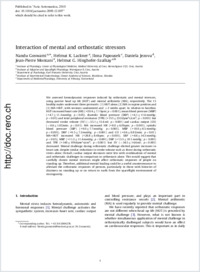Interaction of mental and orthostatic stressors
- Goswami, Nandu Institute of Physiology, Center of Physiological Medicine, Medical University of Graz, Austria
- Lackner, Helmut K. Institute of Physiology, Center of Physiological Medicine, Medical University of Graz, Austria
- Papousek, Ilona Department of Psychology, Karl Franzens University, Graz, Austria
- Jezova, Daniela Institute of Experimental Endocrinology, Slovak Academy of Sciences, Bratislava, Slovakia
- Montani, Jean-Pierre Department of Medicine/Physiology, University of Fribourg, Switzerland
- Hinghofer-Szalkay, Helmut G. Institute of Physiology, Center of Physiological Medicine, Medical University of Graz, Austria - Institute of Adaptive and Spaceflight Physiology, Graz, Austria
-
18.01.2010
Published in:
- Acta Astronautica. - 2011, vol. 68, no. 9-10, p. 1509-1516
English
We assessed hemodynamic responses induced by orthostatic and mental stressors, using passive head up tilt (HUT) and mental arithmetic (MA), respectively. The 15 healthy males underwent three protocols: (1) HUT alone, (2) MA in supine position and (3) MA+HUT, with sessions randomized and ≥2 weeks apart. In relation to baseline, HUT increased heart rate (HR) (+20.4±7.1 bpm; p<0.001), mean blood pressure (MBP) (+4.7±11.3 mmHg; p<0.05), diastolic blood pressure (DBP) (+6.1±11.6 mmHg; p<0.05) and total peripheral resistance (TPR) (+155±232 dyne*s/cm⁵; p<0.001) but decreased stroke volume (SV) (−33.1±13.4 ml; p<0.001) and cardiac output (CO) (−0.6±1.0 l/min; p<0.01). MA increased HR (+8.0±6.0 bpm; p<0.001), systolic blood pressure (SBP) (+9.0±7.7 mmHg; p<0.001), MBP (+10.0±6.5 mmHg; p<0.001), DBP (+9.5±7.2 mmHg; p<0.001) and CO (+0.6±0.8 l/min; p<0.01). MA+HUT increased HR (+28.8±8.4 bpm; p<0.001), SBP (+4.6±14.3 mmHg; p<0.05), MBP (+11.2±11.6 mmHg; p<0.001), DBP (+13.5±10.1 mmHg; p<0.001) and TPR (+160±199 dyne*s/cm⁵; p<0.001) but SV (−34.5±14.6 ml; p<0.001) decreased. Mental challenge during orthostatic challenge elicited greater increases in heart rate, despite similar reductions in stroke volume such as those during orthostatic stress alone. Overall, cardiac output decreases were less with combinations of mental and orthostatic challenges in comparison to orthostasis alone. This would suggest that carefully chosen mental stressors might affect orthostatic responses of people on standing up. Therefore, additional mental loading could be a useful countermeasure to alleviate the orthostatic responses of persons, particularly in those with histories of dizziness on standing up or on return to earth from the spaceflight environment of microgravity.
- Faculty
- Faculté des sciences et de médecine
- Department
- Département de Médecine
- Language
-
- English
- Classification
- Biological sciences
- License
-
License undefined
- Identifiers
-
- RERO DOC 17288
- DOI 10.1016/j.actaastro.2009.12.007
- Persistent URL
- https://folia.unifr.ch/unifr/documents/301474
Statistics
Document views: 119
File downloads:
- pdf: 213
